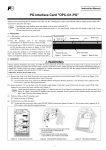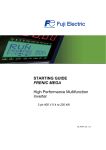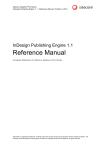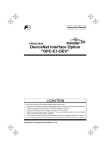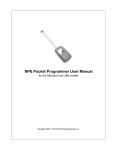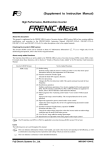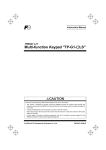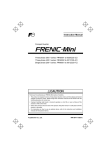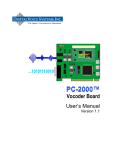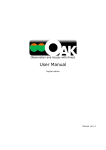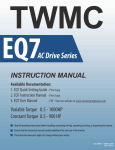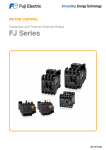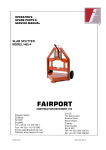Download FRENIC-VP Pump Control
Transcript
Instruction Manual Designed for Fan and Pump Applications FRENIC-VP Pump Control Thank you for purchasing our FRENIC-VP series of inverters. • This product is designed to drive a three-phase induction motor. Read through this instruction manual and be familiar with the handling procedure for correct use. • Improper handling might result in incorrect operation, a short life, or even a failure of this product as well as the motor. • Deliver this manual to the end user of this product. Keep this manual in a safe place until this product is discarded. • For how to use an optional device, refer to the installation and instruction manuals for that optional device. Fuji Electric FA Components & Systems Co., Ltd. Preface The FRENIC-VP series of inverters for fan and pump applications (for variable torque load) is capable of dynamically driving more than one pump. This manual describes the pump drive and lists points that should be noted during operation. Read through this manual in conjunction with the FRENIC-VP Instruction Manual. Table of Contents Chapter 1 Overview .......................................................................................................................................... 1 Chapter 2 2.1 Specifications ................................................................................................................................... 2 Dynamic Rotation of Pump Motors .......................................................................................................... 3 2.1.1 With a fixed inverter-driven motor..................................................................................................... 3 2.1.2 With a floating inverter-driven motor................................................................................................. 4 2.1.3 Chapter 3 Assignment to output terminals ........................................................................................................ 5 Function Codes ................................................................................................................................ 6 3.1 List of Function Codes............................................................................................................................. 6 3.2 Details of Function Codes........................................................................................................................ 9 Chapter 1 Overview "Pump control" refers to controlling more than one pump motor by a single inverter. The inverter selectively drives one of pump motors in a liquid dispatch system, while switching power sources of other pump motors to commercial power lines as required. In the pump control, the PID controller integrated in the inverter processes the PID command such as flowrate or pressure. When the inverter-driven motor is no longer sustain the discharge flowrate required, the inverter issues an output signal that dynamically switches the power source for individual motors between the inverter output and commercial lines or mounts a commercial power-driven motor(s). If the discharge flowrate is low, for example, the inverter drives one of the motors; if higher, it mounts more motors driven by commercial power in order to ensure the total discharge flowrate required. This pump control system further works to even the historical operation conditions of motors such as the cumulative run time. The pump control system is available in two configurations: one with a fixed inverter-driven motor and the other with a floating inverter-driven motor. The details are described later in this manual. 1 Chapter 2 Specifications Dynamic rotation of pumps Item With a fixed inverter-driven motor With a floating inverter-driven motor Maximum number of pumps to drive Inverter-driven: 1 Commercial power-driven: 4 Inverter- and commercial power-driven: 3 Applicable motor rating All pump motors managed by the inverter shall be of the same rating. Remarks Optional relay output card (OPC-F1S-RY) required Control PID control integrated in the inverter Motor mount/unmount order The inverter automatically mounts or unmounts a motor(s) to even the cumulative run time of all motors. Periodic motor switching The inverter switches motors at the specified intervals even if the number of motors in operation does not change. Selectable by function code data Motor stop mode Choice of the following two: To stop all motors or only the inverter-driven one with a Stop command issued to the inverter Selectable by function code data Forced stop Using function code data or digital input enables or disables a forced stop for individual motors. Selectable by function code data Cumulative run time The cumulative run time can be monitored for individual motors. Cumulative number of relay ON times The cumulative number of ON/OFF switching times can be monitored for each relay. Clear periodic switching time The interval for periodic switching can be reset to zero by terminal command (MCLR) from the external equipment. Motor mount/unmount command (M1_L): Mount motor 1, commercial-powerdriven (M1_I): Mount motor 1, inverter-driven (M2_L): Mount motor 2, commercial-powerdriven (M1_L): Mount motor 1, commercial-power-d riven (M3_L): Mount motor 3, commercial-powerdriven (M2_I): Mount motor 2 inverter-driven (M4_L): Mount motor 4, commercial-powerdriven (M2_L): Mount motor 2 commercial-power-d riven (M3_I): Mount motor 3 inverter-driven (M3_L): Mount motor 3 commercial-power-d riven Periodic switching early warning signal Pump control limit signal This signal gives the external equipment an early warning of the periodic switching. The inverter issues this signal when it detects such a condition that requires further mounting a motor(s) even after all pump motors are in operation. 2 Selectable by function code data These signals can be assigned to transistor output [Y1] to [Y3], relay contact output [Y5A/C], [30A/B/C], or relay output card's [Y1A/B/C] to [Y3A/B/C]. 2.1 Dynamic Rotation of Pump Motors 2.1.1 With a fixed inverter-driven motor This configuration consists of a motor driven by the inverter (M0) and motors driven by commercial power (M1 to M4). The inverter-driven motor is fixed at M0 and is controlled for variable speed. When the inverter-driven motor M0 alone cannot sustain the desired discharge flowrate, the inverter mounts one or more motors driven by commercial power as necessary. 3 2.1.2 With a floating inverter-driven motor In this configuration, all the motors can be driven by the inverter or commercial power. At the start of operation, each motor is driven by the inverter and is controlled for varying speed. When the first motor alone cannot sustain the desired discharge flowrate, it is switched to commercial-power operation, and the inverter drives the second motor. 4 2.1.3 Assignment to output terminals In the pump control, contactors (relay outputs) are used to change the configuration of several pump motors or to run/stop them. The following number of contactor control signal lines is required for motor control: Configuration with a fixed inverter-driven motor: Max. 4 output signal lines (4 motors x 1 line/motor) Configuration with a floating inverter-driven motor: Max. 6 output signal lines (3 motors x 2 lines/motor) The inverter has five output terminals (Y1, Y2, Y3, Y5A/C, and 30A/B/C) as standard. If more are needed, use output terminals (Y1A/B/C, Y2A/B/CRY, and Y3A/B/CRY) of an optional relay output card. Using the relay output card for pump control requires setting up its contact functions for Y1, Y2, and Y3 on the inverter with function codes J45 to J47. When the card is used for the original purpose, that is, for converting Y1, Y2, and Y3 signals to relay contact ones, no special setup is required. 5 Chapter 3 Function Codes 3.1 List of Function Codes The table below lists the function codes associated with pump control. For the details of PID and other controls, refer to the Instruction Manual and the User’s Manual of the inverter. Code Name Data setting range Unit Change when running - - N Y 6 - - N Y 7 Data Default copying setting E01 Command Assignment to [X1] E02 [X2] E03 [X3] 50 (1050): Clear periodic switching time (MCLR) - - N Y 8 E04 [X4] 51 (1051): Enable pump drive (motor 1) (MEN1) - - N Y 11 E05 [X5] 52 (1052): Enable pump drive (motor 2) (MEN2) - - N Y 35 E98 [FWD] 53 (1053): Enable pump drive (motor 3) (MEN3) E99 [REV] 54 (1054): Enable pump drive (motor 4) (MEN4) Refer to the instruction manual of the inverter for data other than listed below. - - N Y 0 E20 Signal Assignment to: (Transistor signal) Refer to the instruction manual of the inverter for data other than listed below. Increment Refer to page: 9 9 E21 [Y1] 60 (1060): Mount motor 1 driven by inverter (M1_I) - - N Y 1 E22 [Y2] 61 (1061): Mount motor 1 driven by commercial power (M1_L) - - N Y 2 E24 [Y3] 62 (1062): Mount motor 2 driven by inverter (M2_I) - - N Y 15 63 (1063): Mount motor 2 driven by commercial power (M2_L) - - N Y 99 1 - N Y 0 10 10 E27 (Relay contact signal) [Y5A/C] 64 (1064): Mount motor 3 driven by inverter (M3_I) [30A/B/C] 65 (1065): Mount motor 3 driven by commercial power (M3_L) 67 (1067): Mount motor 4 driven by commercial power (M4_L) 68 (1068): Periodic switching early warning (MCHG) 69 (1069): Pump control limit signal (MLIM) J25 Pump Control 0: Disable (Mode selection) 1: Enable (Fixed inverter-driven motor) J26 Motor 1 Mode 0: Disable (Always OFF) 1 - Y Y 0 J27 Motor 2 Mode 1: Enable 1 - Y Y 0 J28 Motor 3 Mode 2: Force to run by commercial power 1 - Y Y 0 J29 Motor 4 Mode 1 - Y Y 0 J30 Motor Switching Order 1 - Y Y 0 11 1 - Y Y 0 12 2: Enable (Floating inverter-driven motor) 0: Fixed 1: Automatically (Constant run time) J31 Motor Stop Mode 0: Stop all motors (inverter- and commercial power-driven) 1: Stop inverter-driven motors only (excl. alarm state) 2: Stop inverter-driven motors only (incl. alarm state) 6 Code table continued. Code J32 Name Periodic Switching Time for Motor Drive Data setting range 0.0: Disable switching Increment Unit Change when running 1 - Y Y 0 13 0.01 s Y Y 0.1 14 1 Hz Y Y 999 15 Data Default copying setting Refer to page: 0.1 to 720.0 h: Switching time range 999: Fix to 3 minutes J33 Periodic Switching Signaling Period 0.00 to 600.00 J34 Mount of Commercial Power-driven Motor 0 to 120 999: Depends on setting of J18 (Frequency) (This code is used to judge whether or not to mount a commercial power-driven motor by checking the output frequency of the inverter-driven motor.) J35 (Duration) 0.00 to 3600 J36 Unmount of Commercial Power-driven Motor 0 to 120 999: Depends on setting of J19 (Frequency) (This code is used to judge whether or not to unmount a commercial power-driven motor by checking the output frequency of the inverter-driven motor.) Variable s Y Y 0 1 Hz Y Y 999 J37 (Duration) 0.00 to 3600 Variable s Y Y 0 J38 Contactor Delay Time 0.01 to 2.00 0.01 s Y Y 0.1 J39 Switching Time for Motor Mount (Deceleration time) 0.00: Depends on the setting of F08, 0.01 to 3600 Variable s Y Y 0 (Acceleration time) 0.00: Depends on the setting of F07, 0.01 to 3600 Variable s Y Y 0 J41 Motor Mount/Unmount Switching Level 0 to 100 1 % Y Y 0% J42 Switching Motor Mount/Unmount 0.0: Disable (Dead band) 0.1 to 50.0 PID Control Startup Frequency 0: Disable 1 to 120 999: Depends on the setting of J36 J40 J43 17 15 Switching Time for Motor Unmount 15 17 7 0.1 % Y Y 0.00% 1 Hz Y Y 999 17 Code table continued. Code J45 Name Signal Assignment to: (For relay output card) Data setting range 100: Depends on setting of E20 to E22 Change Data Refer Default when copyin to setting running g page: Increment Unit 1 - N Y 100 J46 [Y1A/B/C] 60 (1060): Mount pump motor 1 driven by inverter (M1_I) 1 - N Y 100 J47 [Y2A/B/C] 61 (1061): Mount pump motor 1 driven by commercial power (M1_L) 1 - N Y 100 1 h Y Y - 9 [Y3A/B/C] 62 (1062): Mount pump motor 2 driven by inverter (M2_I) 63 (1063): Mount pump motor 2 driven by commercial power (M2_L) 64 (1064): Mount pump motor 3 driven by inverter (M3_I) 65 (1065): Mount pump motor 3 driven by commercial power (M3_L) 67 (1067): Mount pump motor 4 driven by commercial power (M4_L) 68 (1068): Periodic switching early warning (MCHG) 69 (1069): Pump control limit signal (MLIM) J48 Cumulative Run Time of Indication of cumulative run time of motor for Motor (Motor 0) replacement J49 (Motor 1) 1 h Y Y - J50 (Motor 2) 1 h Y Y - J51 (Motor 3) 1 h Y Y - J52 (Motor 4) 1 h Y Y - 1 Times Y Y - - J53 Maximum Cumulative Number of Relay ON Times Indication of the maximum number of ON times of relay contacts on the relay output card or those built in inverter [Y1A/B/C] to [Y3A/B/C] Display of 1.000 means 1000 times. J54 [Y1], [Y2], [Y3] For relay output card 1 Times Y Y J55 [Y5A], [30A/B/C] For built-in mechanical contacts 1 Times Y Y 8 17 17 3.2 Details of Function Codes This section describes the function codes that are used for pump control. For the description of function codes not found here, refer to the Instruction Manual and the User’s Manual of the inverter. E01 to E05, E98, E99: Command Assignment to Terminals [X1] to [X5], [FWD], and [REV] Function codes E01 to E05, E98 and E99 allow you to assign commands to general-purpose, programmable input terminals [X1] to [X5], [FWD], and [REV]. For the programmable input functions other than pump control, refer to the Instruction Manual of the inverter. < Pump Control Functions > Assignment of "Clear periodic switching time" command (MCLR) (E01 to E05, E98, E99 = 50) Assignment of "Enable pump drive" commands (MEN1) to (MEN4) (E01 to E05, E98, E99 = 51, 52, 53, 54) For details, refer to the description of each function code in this manual. (J32: Periodic switching time for motor drive, J26 to J29: Motor 1 mode to Motor 4 mode.) E20 to E22, E24, E27, J45 to J47: Signal Assignment to Terminals [Y1] to [Y3], [Y5A/C], [30A/B/C], and [Y1A/B/C] to [Y3A/B/C] Function codes E20 to E22, E24 and E27 allow you to assign output signals to general-purpose, programmable output terminals [Y1] to [Y3], [Y5A/C], and [30A/B/C]. If more terminals are needed, terminals [Y1A/B/C], [Y2A/B/C], and [Y3A/B/C] on the optional relay output card can be used as general-purpose programmable output terminals (for pump functions only). For the programmable output functions other than pump control, refer to the Instruction Manual for the inverter. Note: If J45 to J47 = 100, terminals [Y1A/B/C] to [Y3A/B/C] provide the same output signals as terminals [Y1] to [Y3]. Further, you cannot assign any functions other than those associated with pump control. < Pump Control Functions > Assignment of "Mount pump motor" command signals (M1_I) to (M3_I) and (M1_L) to (M4_L) (E20 to E22, E24, E27, J45 to J47 = 60 to 67) Specify "Mount pump motor" command signals according to the configuration and the number of pump motors, as listed below. Item "Mount pump motor" command signals Configuration with a fixed inverter-driven motor Configuration with a floating inverter-driven motor (M1_L): Mount pump motor 1, commercial-power-driven (M1_I): Mount pump motor 1, inverter-driven (M2_L): Mount pump motor 2, commercial-power-driven (M1_L): Mount pump motor 1, commercial-power-driven (M3_L): Mount pump motor 3, commercial-power-driven (M2_I): Mount pump motor 2, inverter-driven (M4_L): Mount pump motor 4, commercial-power-driven (M2_L): Mount pump motor 2, commercial-power-driven (M3_I): Mount pump motor 3, inverter-driven (M3_L): Mount pump motor 3, commercial-power-driven 9 Assignment of "Periodic switching early warning" signal (MCHG) (E20 to E22, E24, E27, J45 to J47 = 68) For details, refer to the description of the related function code. (J33: Periodic switching signaling period) Assignment of "Pump control limit signal" (MLIM) (E20 to E22, E24, E27, J45 to J47 = 69) This signal turns on when the inverter detects such a condition that requires further mounting a motor(s) by J34 and J35 even after all pump motors are in operation. This signal can thus detect a situation where the output flowrate (pressure) does not increase because of a pipe crack or other reasons. J25: Pump Control (Mode selection) Pump control is effective only when J25 = 1 or 2 and the PID control integrated in the inverter is enabled (J01 ≠ 0). J25 specifies the configuration of dynamic motor rotation with a fixed inverter-driven motor or with a floating inverter-driven motor. J26 to J29: Motor 1 Mode to Motor 4 Mode J26 to J29 allow you to specify the number of pump motors to be controlled and unmount a pump motor(s) from the control system. The combination of J26 to J29 and "Enable pump drive" commands (MEN1) to (MEN4) assigned to the digital input terminals makes it also possible to enable or disable pump control. Assignment of "Enable pump drive" commands (MEN1) to (MEN4) (E01 to E05, E98, E99 = 51, 52, 53, 54) The operation of each pump motor is determined by the combination of J26 to J29 and "Enable pump drive" commands (MEN1) to (MEN4) as listed below. Motor 1 Mode to Motor 4 Mode (J26 to J29) 0 1 2 "Enable pump drive" (MEN1) to (MEN4) - Operation Disable: Disable both inverter- and commercial power-driven motors. ON Enable: Under pump control OFF Disable: Disable both inverter- and commercial power-driven motors. ON Force to run (Forced ON): Forcibly switch from “Driven by inverter” to “Driven by commercial power,” regardless of Run commands. OFF Disable: Disable both inverter- and commercial power-driven motors. Note: When the inverter is driving a forced-ON motor, changing data of J26 to J29 from "2" (Force to run) to "1" (Enable) continues to run the motor by commercial power under PID control. When the inverter is stopped, changing data of J26 to J29 from "2" (Force to run) to "1" (Enable) determines the operation of the motor specified for "Force to run" depending upon the data of J31 (Motor stop mode). If J31 = 0, the motor will stop. If J31 = 1 or 2, it will continue to run by commercial power. 10 J30: Motor Switching Order In pump control, the inverter manages the number of motors to be driven. J30 specifies the mount/unmount motor sequence. Data 0 1 Operation The inverter mounts motors in ascending order of their numbers, i.e., Motor 1 → Motor 2 → Motor 3 → Motor 4 and unmounts them in descending order. When restarting the motors after coast-to-stop, the inverter mounts Motor 1 first. To even the cumulative run time among the motors, the inverter mounts the motor whose cumulative run time is shortest first and unmounts the one whose cumulative run time is longest first. 11 J31: Motor Stop Mode J31 specifies how to stop the pump motors when a Run command (FWD or REV) is turned OFF under pump control. Data Operation The inverter-driven motor decelerates to the stop frequency (F25) during the deceleration time (F08) to stop. 0 As soon as the output of the inverter is shut down, the relays for the inverter-driven motor are turned OFF. The relays for all the motors driven by commercial power are turned OFF when the inverter has come to a stop. Also in an alarm state, all the motors are brought to a stop: the output to the inverter-driven motor is turned OFF and the relays for the commercial-power-driven motors are turned OFF. The inverter-driven motor decelerates to the stop frequency (F25) during the deceleration time (F08) to stop. 1 As soon as the output of the inverter is shut down, the relays for the inverter-driven motor are turned OFF. Note that other relays remain ON so that the commercial-power-driven motors continue to run. In an alarm state, all the motors are brought to a stop: the output to the inverter-driven motor is turned OFF and the relays for the commercial-power-driven motors are turned OFF. The inverter-driven motor decelerates to the stop frequency (F25) during the deceleration time (F08) to stop. 2 As soon as the output of the inverter is shut down, the relays for the inverter-driven motor are turned OFF. Note that other relays remain ON so that the commercial-power-driven motors continue to run. In an alarm state, only the output to the inverter-driven motor is turned OFF but the relays for the commercial-power-driven motors remain ON. The commercial-power-driven motors continue to run. Note: To stop commercial-power-driven motors when J31 is set at “1” or “2,” take one of the following actions:- • To stop pump motors individually, specify “Disable” for them using J26 to J29. • To stop pump motors individually, turn OFF their corresponding "Enable pump drive" commands (MEN1) to (MEN4) assigned to the input terminals. • To stop all the commercial-power-driven motors, disable pump control (J25 = 0 or J01 = 0). • To stop all the commercial-power-driven motors, input the "Coast-to-stop" command (BX). 12 J32: Periodic Switching Time for Motor Drive The periodic switching time for motor drive is designed to balance the cumulative run time among multiple motors for extending the life of the pump motors and preventing rust. When the number of motors in operation does not change for the specified period, the inverter dynamically swaps the motors in operation. Data 0.0 Operation Disable periodic switching. Enable periodic switching. When, during stable PID operation, the number of motors in operation does not change for the specified period (0.1 - 720.0h), the motors in operation are switched as follows: <Configuration with a fixed inverter-driven motor> Of the motors driven by commercial power, the one with the longest cumulative run time is turned OFF (relay output is turned OFF); at the same time, the one with the shortest one is turned ON (relay output is turned ON). <Configuration with a floating inverter-driven motor> The inverter-driven motor is turned OFF (output is shut down) and the one with the shortest cumulative run time is turned ON (see the figure below). 0.1h to 720.0h Enable periodic switching for operation check. 999 The operation is the same as above, except that the periodic switching time is fixed at 3 minutes. This setting is used to check operation at the start of the system. Note: Periodic switching is not applicable to motors specified for "Force to run by commercial power" by J26 to J29 (data = 2). 13 Assignment of "Clear periodic switching time" command (MCLR) (E01 to E05, E98, E99=50) As long as (MCLR) is ON, the periodic switching timer is reset to “0.” To restart the timer, turn OFF (MCLR). J33: Periodic Switching Signaling Period J33 specifies the output timing of the periodic switching early warning signal (MCHG). Assignment of "Periodic switching early warning signal (MCHG) (E20 to E 22, E24, E27, J45 to J47 = 68) When the periodic switching conditions are met, the inverter outputs a periodic switching early warning for the period specified by J33 and then enters actual switching operation. This signal, therefore, can be used as an early warning of periodic switching. 14 J34 to J37: Mount of Commercial Power-driven Motor (Threshold frequency and duration) J39, J40: Switching Time for Motor Mount (Deceleration time), Switching Time for Motor Unmount (Acceleration time) J41: Motor Mount/Unmount Switching Level < Mounting motor(s) > When the PID output (which is fed to the inverter-driven motor) has exceeded the threshold frequency (specified by J34) longer than the duration specified by J35, the inverter mounts a pump motor(s). When a decision is made to mount a motor, the inverter-driven motor decelerates to the threshold frequency (J36) for the motor mount switching time (deceleration time specified by J39) and then restarts PID control. The motor to be mounted starts being driven by commercial power when the inverter-driven motor has reached the motor mount/unmount switching level (J41) during deceleration. The motor mount/unmount switching level (J41) serves as an adjuster for ensuring smooth transition (switch-over) and operates at the timing indicated by the following formula: Switching frequency (Hz) = (J41/100%) x (J18 - J19) + J19, where J18 = PID upper limiter and J19 = PID lower limiter. 15 < Unmounting motor(s) > When the PID output (which is fed to the inverter-driven motor) has been dropped below the threshold frequency (specified by J36) longer than the duration specified by J37, the inverter unmounts a pump motor(s). When a decision is made to unmount a motor, the inverter-driven motor accelerates to the threshold frequency (J34) for the motor unmount switching time (acceleration time specified by J40) and then restarts PID control. Commercial power to the motor to be unmounted is cut OFF when the inverter-driven motor has reached the motor mount/unmount switching level (J41) during acceleration. The motor mount/unmount switching level (J41) serves as an adjuster for ensuring smooth transition (switch-over) and operates at the timing indicated by the following formula: Switching frequency (Hz) = (J41/100%) x (J18 - J19) + J19, where J18 = PID upper limiter and J19 = PID lower limiter. It is recommended that the PID upper and lower limiters (J18, J19) be specified wider than the band specified by the threshold frequencies (J34, J36). In this way, the monitoring of the frequency going above or below the frequencies starts before it reaches the PID upper or lower limiter (J18, J19). This results in a shorter duration of the flowrate being limited, thereby minimizing the fluctuation of pressure when the number of motors is mounted or unmounted. Upper limit of PID process output (J18) = Threshold frequency for mounting of a commercial-power-driven pump motor (J34) Upper limit of PID process output (J18) > Threshold frequency for mounting of a commercial-power-driven pump motor (J34) 16 J38: Contactor Delay Time J38 specifies the contactor delay time or latency (delay in relay or contactor activation) to be incorporated when the motor power source is switched from the inverter to commercial power when a motor is mounted. J42: Switching Motor Mount/Unmount (Dead band) J42 suppresses the mount/unmount of a pump motor when the difference between the PID process command value and the feedback value is smaller than its setting value band. This feature is provided to prevent frequent actions of mounting or unmounting motors just around the threshold frequencies (J34, J36). J43: PID Control Startup Frequency When turning ON a Run command starts a pump motor, the inverter accelerates the motor up to the frequency specified by J43 for the acceleration time specified by F07 and then starts PID control. J48 to J52: Cumulative Run Time of Motor J48 to J52 allow you to monitor the cumulative run time of each motor as reference data useful for maintenance. The cumulative run time can be displayed in units of 1 hour in decimal format on the multi-function keypad or in hexadecimal format on the remote keypad. The cumulative run time can be modified only through a keypad and cleared by setting “0h.” Reset the cumulative run time whenever you replace a pump or as required during maintenance. J53 to J55: Maximum Cumulative Number of Relay ON Times During pump control, external relays and relays on the relay output card are frequently turned ON or OFF by transistor outputs Y1 to Y3. J53 to J55 allow you to monitor the number of ON times by relay group, which serves an indicator of relay life. The maximum cumulative number of relay ON times is displayed in units of 1,000 (A display of 1.000 means 1,000 ON times). The cumulative number goes back to zero (0) when the number of actual ON times overruns 1,000,000. You can reset the cumulative number of relay ON times to “0” only through a keypad. Reset it whenever you replace a relay. Output Life Contact Capacity Transistor output (Y1, Y2, Y3) (Determined by specifications of external relay) - Y5A/C, 30A/B/C (control board in inverter) 200,000 times (when turned ON every second) 250 VAC 0.3 A 200,000 times (when turned ON every second) 250 VAC 0.3 A Relay output card (Y1A/B/C, Y2A/B/C, Y3A/B/C) 17 48 VDC 0.5 A 48 VDC 0.5 A Other notices on pump control a) The electronic thermal overload protection (F10), PTC thermistor (H26) or cumulative motor run time (Menu 5_23) cannot be used since they are not compatible with inverter operation of the dynamic pump motor rotation. b) While pump control is in effect, the restart mode after momentary power failure (Mode selection) works differently as shown below. Data of F14 Restart mode when pump control is not in effect 0 Disable restart (Trip immediately) 1 Disable restart (Trip after a recovery from power failure) 3 Enable restart (Continue to run, for heavy inertia or general loads) 4 Enable restart (Restart at the frequency at which the power failure occurred, for general loads) 5 Enable restart (Restart at the starting frequency, for low-inertia load) Restart mode when pump control is in effect Disable restart (Trip immediately) (same as F14 = 0) Enable restart (Restart at the starting frequency, for low-inertia load) (same as F14 = 5) c) No commercial-power-switching terminal commands (SW50), (SW60), (ISW50) and (ISW60) can be used. d) The slow flowrate stop function of PID control can be used. e) When pump control is in effect, the "Coast-to-stop" terminal command (BX) is used to stop (shut down) all pump motors, regardless of being driven by the inverter or by commercial power. For a configuration allowing commercial-power-driven motors to continue running even after a Run command is turned OFF, it is recommended that the (BX) input be provided. 18 Indication Diagrams for Dynamic Rotation of Pump Motors (1) With a fixed inverter-driven motor 19 (2) With a floating inverter-driven motor 20 Designed For Fan and Pump Applications FRENIC-VP Pump control Instruction Manual First Edition, May 2005 Fuji Electric FA Components & Systems Co., Ltd. The purpose of this instruction manual is to provide accurate information in handling, setting up and operating of the FRENIC-VP series of inverters. Please feel free to send your comments regarding any errors or omissions you may have found, or any suggestions you may have for generally improving the manual. In no event will Fuji Electric FA Components & Systems Co., Ltd. be liable for any direct or indirect damages resulting from the application of the information in this manual. Fuji Electric FA Components & Systems Co., Ltd. Mitsui Sumitomo Bank Ningyo-cho Bldg., 5-7, Nihonbashi, Odemma-cho, Cyuo-ku, Tokyo, 103-0011, Japan Phone: +81 3 5847 8011 Fax: +81 3 5847 8172 URL http://www.fujielectric.co.jp/fcs/

























